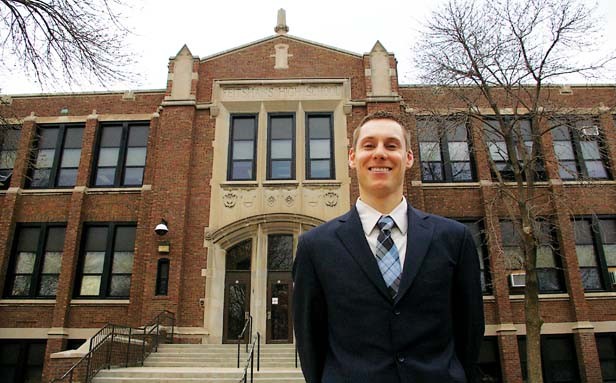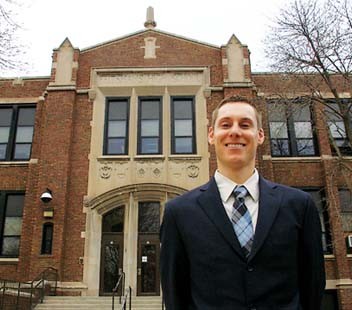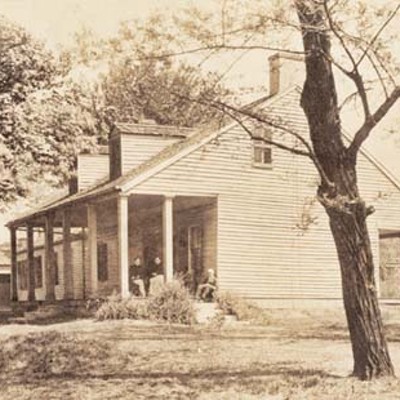
District 186 Superintendent Dr. Walter Milton dreams of a Springfield public school system full of “choice,” with a series of magnet schools, which accept students regardless of where they live within the district, that teach the three R’s with unique approaches and focused missions. To that end, the district opened in August the new Capital College Preparatory Academy, a middle school designed to send 100 percent of its graduates to and through college. In support of the new program, the district in March approved a plan for CCPA’s expansion. If Milton has his way, within the next two years the district will be developing yet another specialized school, or magnet school, designed to draw students from across the district.
All of this, Milton says, is the way to keep Springfield students engaged in their learning and district parents engaged in Springfield public schools. In addition to boosting some students’ academic achievement, offering “choice” is a way to keep families from fleeing either to less-urban districts or to independent but district-funded charter schools, he adds. “Capital College is not for everyone, but if you go to a restaurant and you look at the menu, you have different options to satisfy your taste buds, and that’s what we want to do for families. We believe that we can attract more families … from all ends,” Milton says.
But Milton’s first move toward more choice in Springfield schools has been controversial. The expansion of CCPA necessarily means the end of another magnet school, Feitshans Academy, a kindergarten through fifth-grade elementary school, which has been housed for a decade in the same 1101 S. 15th Street building, where Feitshans High School was housed until it closed in 1967. The year-by-year phaseout of Feitshans Academy, starting with kindergarten in the next school year, to make room for new CCPA students also highlights the impact of the district’s first flirtation with choice schools.
In 2000, District 186 entered the choice arena, opening its first three magnet schools – Feitshans; Iles, a school for gifted students; and the technology-focused Lincoln Magnet – all at the same time, a response to the 1998 opening of Springfield’s first charter school, Ball Charter, says Bob Hill, former District 186 superintendent. While Ball Charter, Lincoln Magnet and Iles all continue to thrive, Feitshans falls short. Though Milton’s long-term vision for District 186’s future includes a fine arts magnet school, Feitshans – itself a fine arts magnet school – won’t be it.
The district’s decision to phase out Feitshans has upset devoted Feitshans parents, but as they lobbied the school board to abort plans for a Feitshans phaseout, school board president Bill Looby offered one inarguable truth: “The parents at Feitshans and the staff are very passionate about their school, but it’s a choice district school that less and less people choose every year, precipitously.” Once with more than 600 students enrolled, Feitshans now hosts only 267 students, down significantly even from last year’s 324-student enrollment.

That population decline may be rooted in Feitshans’ first year, when, according to articles published at that time by the State Journal-Register, dozens of parents removed their children from the school within just the first few months due to behavior problems. While Ball Charter and Lincoln’s long waiting lists required lottery enrollment systems, and Iles operated on an invitation-only system, Feitshans – with nearly twice the maximum capacity as Lincoln – takes students on a first-come-first-served basis.
Springfield Education Association president Dan Ford, who started teaching in Springfield at Feitshans during its second year, says Feitshans’ enrollment system may have led to a general feeling that the school became a dumping ground for problem students. “The perception of the staff was that other buildings were sending students … who didn’t necessarily fit the profile of the program, but that they just wanted out of the building,” Ford says.
At that time, Feitshans was under the management of Edison Schools Inc., which promised to bring technology and new assessment tools to quickly boost academic achievement. By the end of the second year in operation, the for-profit company managing Feitshans-Edison earned less-than-favorable headlines nationally as its stock price plummeted. Through the five-year contract, academic achievement barely budged, and in 2005 District 186 and Edison Schools Inc. allowed the contract to expire. The district took over the school but kept many of the Edison programs in place.
“Edison was unique. It was a nationally-known model,” says Diane Rutledge, the superintendent who oversaw the school’s move from Edison back to District 186 management. Rutledge is now executive director of the Large Unit District Association, of which District 186 is a member. “Though we didn’t keep it forever, it really served its purpose for a period of time.” She says that, through the Edison model, the district gained experience with online assessment and new curriculum models.
Dan Ford says the change, though in practicality not that significant, may have led to changing views of the school. “I think when Edison went away, they [District 186] maintained the basic design from when Edison was there, but the perception was, if it’s a district school, how is it going to be any different?”
Rachel Thome, a Feitshans parent who opposes the school’s phaseout, acknowledges that Feitshans has always had a bit of a “bad rap,” though she says that the teachers are “excellent,” that her own children have excelled there academically and that the overall test scores of the school are higher than those of Graham Elementary, the school her children would have attended if not for the district’s choice schools.
Feitshans in 2010 did perform significantly better than Graham on the Illinois Standards Achievement Test (ISAT). While 63 percent of Feitshans students met standards last year, only 55 percent of Graham students did the same. Still, several other neighborhood elementary schools, including Sandburg, Owen Marsh, Lindsay, Hazel Dell and Butler, outperformed Feitshans.
Feitshans also scored well below the district’s overall 71 percent passing rate, and far below Iles’ 100 percent, Lincoln’s 96 percent and Ball Charter’s 85 percent passing rates.
Asked why he thinks fewer and fewer parents choose Feitshans each year, Milton emphasizes the importance of marketing and perception. “It really required an intense marketing scheme-up to say ‘OK, we have this fine arts academy and our goal is to let the world know that we exist.’ In our community, you have to continuously put it out there, and that’s where I think Feitshans may not have had the opportunity to expand,” Milton says. “But then there’s a reality too. I think perceptions are made through history, so the history kind of produced this belief that Feitshans was not meeting the demands.”

Thome says her biggest disappointment with the upcoming changes is the way in which the district handled its decision. She says Feitshans parents should have been consulted last year when the district approved the school as the place to house CCPA, and she adds that she, like many parents, was caught off guard this winter when the district decided to start phasing out Feitshans to make room for CCPA.
Thome also suggests, however, that perhaps the district could have put more effort into improving and promoting Feitshans. “It doesn’t seem like the school district as a whole has really focused on Feitshans as much as they should have,” she says, adding that when she talks to other parents about the school, they often haven’t heard of it. “They don’t know about the programs. Lots of people don’t know it’s a magnet school. I don’t think the district itself really utilizes Feitshans as an asset, even from the beginning.”
Thome is supportive of the CCPA program, but she’s disappointed that her youngest child of three will not be able to follow in her siblings’ footsteps to Feitshans next year, and she offers words of caution as she wonders if the district put enough effort into Feitshans throughout its short existence. “I’m worried that maybe CCPA could have the same fate eventually,” she says. “Instead of focusing on schools and programs we have in place, they keep trying other things.” She adds: “I hope that the school board, that if this is a program they want to focus on, that they continue to put forth the effort that it needs to succeed.”
Regardless of how Feitshans came to decline in popularity, Milton is focusing on its fall as an opportunity for growth, not for the elementary school but for the eight-month-old Capital College Preparatory Academy that now hosts fewer than 110 sixth-grade students. Each year, CCPA will add a new grade level, each with 120 students, until it eventually serves students all the way through high school. Grades six through nine will be housed in the Feitshans building, and grades 10 through 12 will attend class on a college campus, possibly at the University of Illinois Springfield.
Uniforms, extended school days, Saturday academies, and an emphasis on STEM (Science, Technology, Engineering and Mathematics) curriculum complement CCPA’s single-gender classrooms. CCPA’s mission is to see every one of its “scholars” not only gain admission to college upon completing high school but also graduate college. In addition to exposure to “a rigorous curriculum,” CCPA students each morning recite the tenets of their program: preparation, respect, excellence and productivity.
Parent Robert Ogden says that he, his wife and his 12-year-old daughter, Amber, chose CCPA over other magnet schools in the district because of its main mission. “Based upon having talked with Amber and letting her understand, this is what it’s about, you’re going to be wearing a uniform, you’ll be in gender-specific classes, but more importantly this is the goal of the school you’re going to be attending – to prepare you for college. That goal is the reason for the choice of the academy.” Already, Ogden says, he can see change for the better in his daughter’s study habits, which he attributes to CCPA’s team mentality and high expectations.
While CCPA students only just took their first ISATs and results won’t be available for months, CCPA principal Chris Colgren says he’s encouraged by results of a type of practice test, designed to match up with the ISAT, that students took in February. Based on those tests, the company that writes them predicts that in math and reading about 94 percent and 92 percent, respectively, of CCPA students should at least meet ISAT standards. On last year’s ISATs, only 71 percent of those who became CCPA’s first sixth grade class met standards in both reading and math.
As for the idea that CCPA could end up one day in the same situation in which Feitshans now finds itself, Colgren says that potential is always a concern for any school, but he adds that he’s confident CCPA’s fidelity to its mission will carry it forward. “The key is to remain very focused to the mission and the vision that you have for the program. As a magnet school, we are a college preparatory program and pursuant to that mission we need to make sure that along this journey we remain committed to that and don’t stray in other directions,” Colgren says.

Milton emphasizes that CCPA is the result of much deliberation and development. When explaining the school’s origins, Milton explains that he’s worked in other districts to introduce single-gender classrooms and rigorous curriculum, but he also credits district staff and the aborted work of three community members. Before Milton arrived in the district, retired educators James Forstall, Allan Woodson and Gordon Smith worked to open a college preparatory program to run within Washington Middle School. Though fundraisers and development workshops brought the proposed program within reach by the end of the 2006-2007 school year, their program was never implemented. Former superintendent Diane Rutledge, who served as superintendent from 2002 until 2007, suggests that the school-within-a-school format they planned, versus the independent program now being built, probably led to the proposal’s end. Though Woodson, Forstall and Smith remain puzzled at the district’s decision not to use their plans, they’re all pleased to see a version of them in place in District 186.
When it comes to adding even more choice to Springfield public schools, not everyone is as eager as Milton. School board president Bill Looby says he supports CCPA as well as the district’s other magnet schools, but he’s cautious about the idea of expanding the district’s choice offerings. “I’m not a big believer in theme schools,” he says. “I think we need to focus on all of our schools.” He says he supports targeted magnet schools that exist to serve a specific group of children in need of a different type of environment, but he adds that choice schools can have a negative effect on the rest of the district.
“You get a sifting effect when you create some of these types of schools. You get higher achieving children and more involved parents that attend or seek to get into those schools,” Looby says. “If we continue a strong, robust investment in all of our schools and neighborhood schools and don’t continue chasing the shiny object, I think that we’ll eventually continue to bring the whole district up.”
As for the Feitshans building, it’s undergoing just another transition, Looby says. Once a high school, it then became a fifth- and sixth-grade attendance center before Edison took it over as a kindergarten through sixth-grade elementary school that, when the district took it over again, later became a kindergarten through fifth-grade elementary school. “They’ve been through transitions already from several setups. I just think that we’re ready to transition and utilize that facility better. … We have to be realistic – we only have so many buildings, we only have so much space.”
Contact Rachel Wells at [email protected].




















